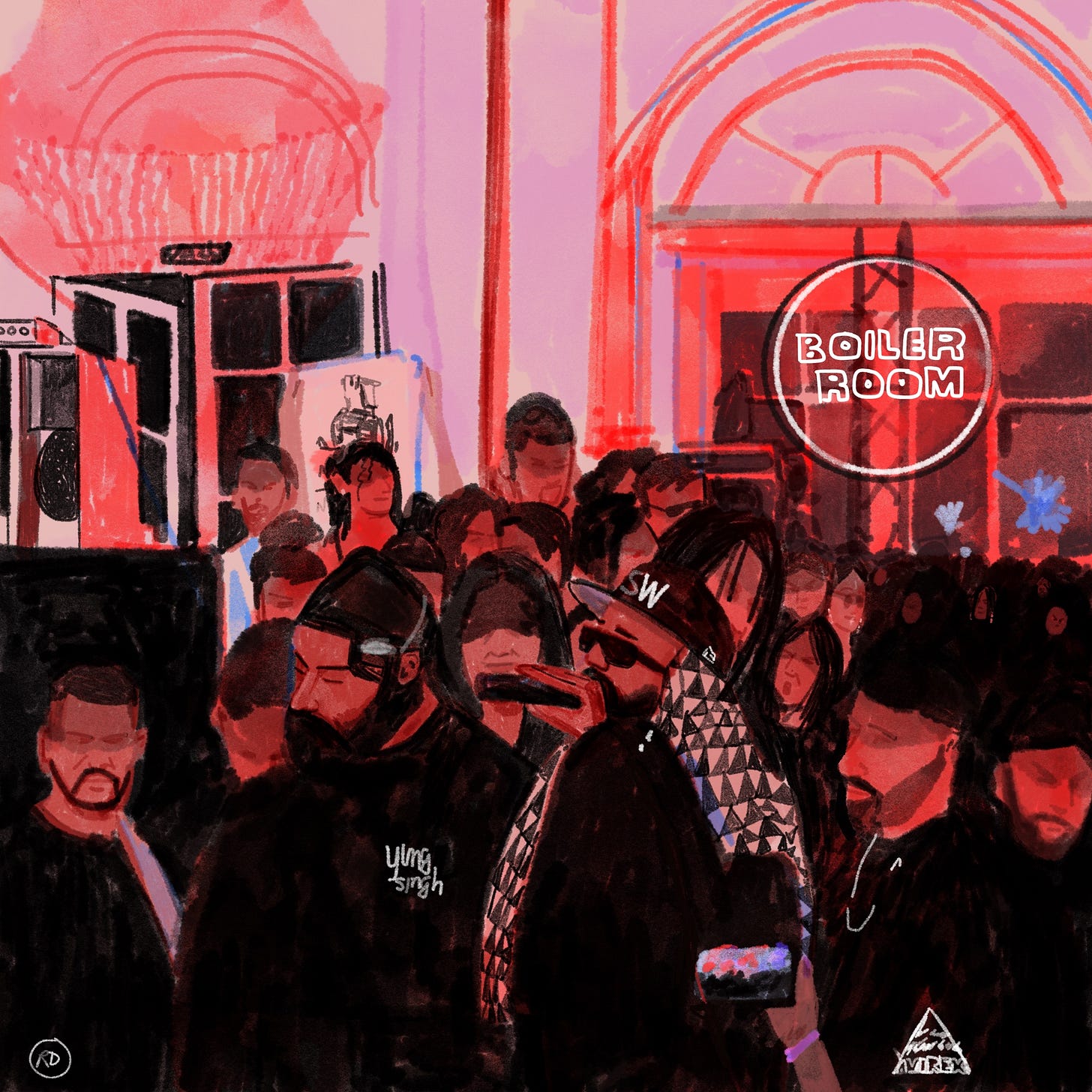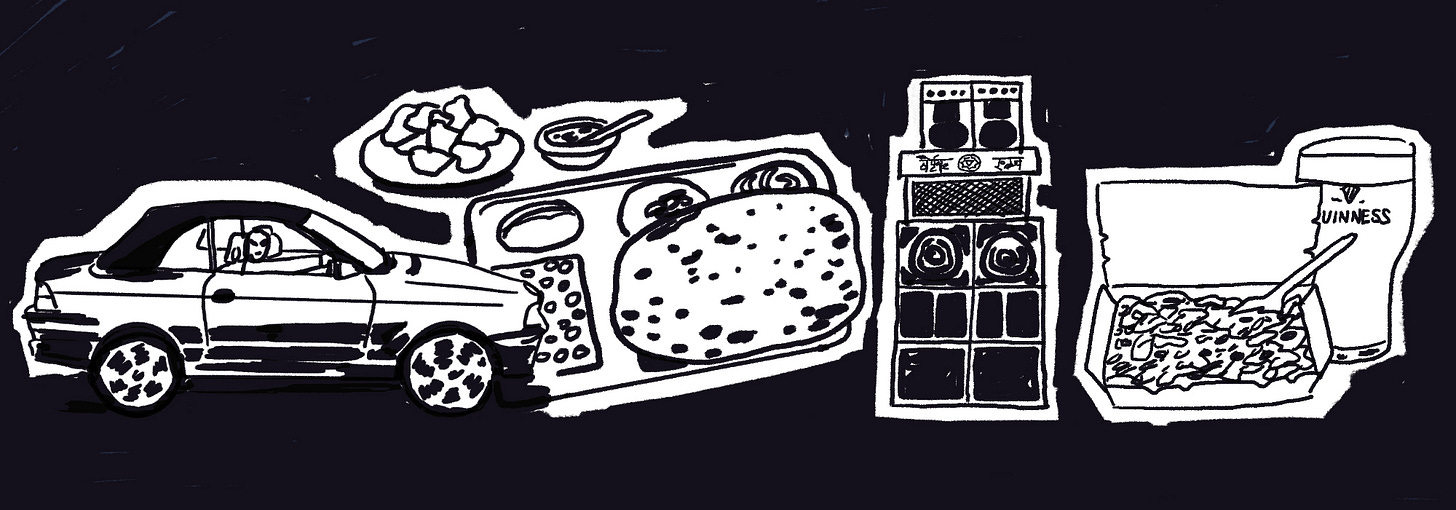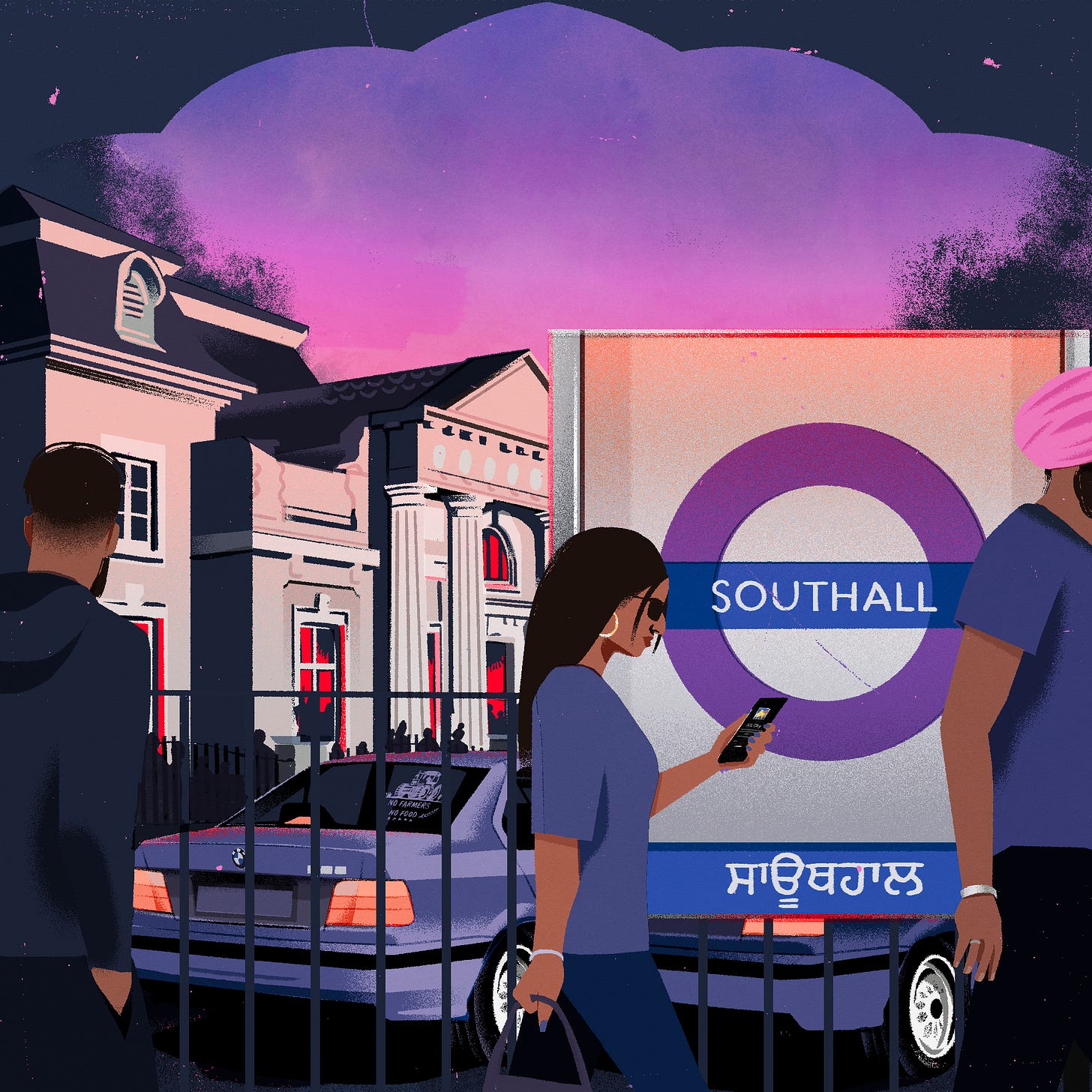Turn Left and Follow the Bass
Southall, in west London, has been disappearing from my life since I was a child. This summer, music helped to keep the fire burning. Art by Raj Dhunna

Red haze. Chandelier shadows. Worn carpet. Way too hot — a boiler room, indeed. Swinging bass. Rustic vocals. ‘No Farmers No Food’ flags blocking my view. Black attire. We’re night-timers, now. Moschino and Avirex, chappal and lehenga. Ten times leng-er. Sharp elbows to catch a glimpse. Close my eyes to feel the dhol in my chest. Step outside to take a breather. Smokers hide, the hungry snack on samosa and chaa. Summer knights. Zimmers and Mercs. A train whizzes by, disappearing under the bridge. Memories come flooding back.
When I was a child, the drive from Surrey to Southall was an event unto itself. I used to sit in the backseat of our family car and lean my head against the window, retreating into my own world between a pair of headphones. My cassette tapes played British artists like Soul II Soul, Maxi Priest and Mark Morrison, and US legends like Michael Jackson, The Eagles and George Benson. Following the turn of the millennium, once I discovered music television channels, my CD Walkman played Mis-Teeq, Linkin Park and So Solid Crew. After that, with the internet and LimeWire, my mini-discs played G-Unit, Rishi Rich and Kano. And so on.
Outside, through the glass, was grey flecked with the bright colours of shopfront typography, like a flock of parakeets perching on concrete. We crossed the Thames and circled Heathrow airport as aeroplanes took off and landed. Factories and Gurdwara domes loomed.
Pass the Prince of Wales. Stop at an off-license to pick up some Bacardi for my thaiya. Left after the Tudor Rose to cross the bridge between the train station’s Gurmukhi-scripted sign and the stilts beneath Shahi Nan Kabab. Strain my neck to see the horizon view along the railway tracks.
Glassy Junction. Quality Foods. Himalaya Palace. The Town Hall. The Mandir behind it, where I go now, occasionally, to remove my shoes, light a candle and ring the bell. Left at the Broadway. Sweet corn and jalebi. Gifto’s Lahore Karahi. McDonalds. Left before the canal, into the warmth of a home away from home.
Born in Ludhiana, at four-years-old, dad had stared through his own window during the family’s first London winter in 1966. Condensation dripped. One room, six bodies, until my grandparents secured a mortgage on Beresford Road.
In the 1970s, the nearby Hambrough Tavern operated a colour bar, preventing Black and brown people from drinking inside. But everything changed on Friday 3rd July 1981, the day before Jon McEnroe won his first Wimbledon tennis title. The pub hosted an ‘Oi!’ punk gig attended by members of the National Front. Skinheads paraded the streets waving swastikas, attacking locals, like they’d done before. But Southall held strong. Molotov cocktails. Holy Smokes. 600 officers. Returning home that night, my uncle stepped off the bus onto broken glass. ‘Neo-Nazis Accused in London Riots’ read a New York Times headline. When a new pub rose from the ashes, dad could walk down to play pool during university holidays. Walk so we could run.
In the 1980s, my grandparents hosted mehfil gatherings in their living room. My dada ji was fond of Bollywood classics, Punjabi folk and Sufi qawwali. He preached spin bowling over pace — “you can deceive the batsman” — and tapped his fingers on the dining table like it was a tabla. My dadi ji kneaded chapati dough, seasoned biriani, stuffed karela, lit incense, led prayer, placed red tikkas on foreheads, tied threads around wrists. Four sons, nine grandchildren. My sisters and I were the youngest, the only ones with a white mum.
In the 1990s, after I was born, our drives to Southall became my escape from a comfortable but stifling minority existence in Surrey. In 2001 we moved closer to Heathrow, but the same sentiment persisted.
I craved the bass lines that rumbled from cars blaring UK garage, bhangra and hip-hop along the Broadway. The bangs of my cousin’s dhol, bright lights of fireworks at Diwali and harsh mutterings of a language I recognised but couldn’t understand. I inhaled the chicken, bhindi, mango pulp and more that was shoved between my cheeks. I embraced eating messily with my hands — freedom from the no-elbows-on-the-table rules of Victorian English dining that punished me with a thwack on my forearm elsewhere.
For the first half of my life, Southall was somewhere to exist on my own terms. An idea to believe in, not just a place to visit. I thought the family base would be there forever, like a limb or loyal cousin.
But when grandma passed away in 2004, it all collapsed. She’d been the shield protecting the pretence of peace. Dad and my uncles stopped talking. The fog of dementia clouded grandpa’s mind. He forgot how to speak English. He forgot who we were. They sold the house on Beresford Road.
For the second half of my life, Southall has been slowly disappearing.
Music helps to keep the fire burning.

On a Friday evening this summer I was picked up from my flat in south west London by Hark1karan, the photographer behind Zimmers of Southall and books like PIND, KISAAN and Grass Roots. He dropped the top of his BMW E46 convertible beneath a cloudless sky as we sped west down the M4. I slid a pair of sunglasses onto my nose and held my face to the wind. The weekend had begun.
As I would write for food newsletter Vittles, we were heading for dinner at Kulcha Express in Hayes, the residential town to the west of Southall. We parked in view of a lion-adorned kambal blanket drying on a fire escape. We took our seats and ordered with precision. The Amritsari fish to start had batter that was golden and crispy like honeycomb. For mains, we chose mix kulcha thalis: bread stuffed with potato, cauliflower and onions, accompanied by a bowl of chana sprinkled with finely-chopped red onions, Irish butter, raita and mixed achar.
Our meal was prologue to the main event, a music night at Brookhouse Football Club, a humble sports pavilion by some playing fields in another part of Hayes. We were hosted there by Vedic Roots, who, in recent years, have been playing their part in upholding west London’s reputation as a dub reggae and classic car hub. They were remembering the celebrated sound system operator Jah Shaka, who passed away in April.
The car park was rammed. Red and blue lights lit up picnic tables where people gathered to smoke. I made my way inside, past the bar and through the dense crowd, minding my bare feet in my new pair of dark brown leather Peshawari chappal, avoiding stomping pairs of black Air Max trainers and flailing arms. A homemade sound system blasted dub music from vinyls spinning on a desk at the front. The two selectors, Taranvir and Rana, went tune-for-tune, stepping with each drumbeat, nodding their heads.
The room rattled like a shack in a storm. My ears strained then adapted. The feeling in my ribcage sparked blurry childhood memories of riding around local A-roads in the backseat of my cousin’s car whilst the speaker in his boot sent vibrations down my spine. The low-end of the bass, crackly sound effects and patois of the vocalists reminded me of disappearing into grime, dubstep and jungle nights as a university student. I entered a nostalgic daze. Hours later, after seeing off a box of papri chaat, Hark drove me back to south London.
When I woke up the next morning, my ears and body were still ringing. It wasn’t a hangover — I’d only drank one beer. After a draining week of writing legal reports as an expert witness and delivering workshops in schools, it was raw, analog sound that had energised me to move and let go. The pilgrimage back to greater west London brought me peace. I sought more of the same.

The first act of Jacqueline Crooks’s magically immersive new novel, Fire Rush, is set in 1979, in the months leading up to the anti-racism protests that consumed Southall in the spring of that year. Based on Crooks’s own life experiences, the book’s young, Black-Caribbean protagonist, Yamaye, lives and breathes dub reggae music whilst navigating early adulthood in Margaret Thatcher’s Britain. At night, she skips along the frosty canal and descends a staircase to dance at The Crypt, an underground club in the cellar of a church. She finds solace, escapism and community there, during a time in which racist door policies in the city centre would have rendered mainstream clubbing as a person-of-colour challenging, if not impossible.
When I spoke to Crooks recently — our conversation will be published as the next City Talks interview — she remembered that although subterranean, late-night blues parties were thrown in hidden nooks like The Crypt, more accessible and widely-attended dances also took place earlier at Southall Community Centre on Merrick Road, round the corner from the train station.
For decades, from the 1970s, when the Black Caribbean youth of west London were building the foundations of a scene, to the 2000s, when young Punjabis like the founders of Vedic Roots were teenagers discovering the dub passions of their elders, visitors would turn left out of the station and follow the bass.
Which is what I found myself doing on 16th August 2023. After closing a few years ago, the former community centre’s white, palatial building is now a popular banquet hall. That night, it was playing host to the much-anticipated Boiler Room: Southall.
It had been another heavy week for me, this time delivering youth work at nearby Feltham Young Offenders’ Institute. I slid on my chappal, headed to Paddington and caught the purple Elizabeth Line that cuts across the capital.
Southall can’t easily be gentrified, given how much of its property is owned by an ecosystem of longstanding families. But its new transport links, the station’s glitzy makeover and the new-build towers that peer over the train tracks are changing the local demographic. Investors who might have stayed away in the past now seek somewhere affordable within the M25. As London expands, Southall finds itself less on the margins and more exposed, for better or worse.
Walking to meet friends for tikka rolls and pints of Asahi at the Prince of Wales in Old Southall made me late to the party. I missed the opening set by Vedic Roots, whose sound system would stand tall behind the decks all night. They were followed by Asian Underground pioneer DJ Ritu and Walsall-bred producer Manj. Passing the parked maroon BMW E30 convertible that features in Hark1karan’s most recent documentary, Zimmers of Southall 2, I entered through the back door as host Naina welcomed BBC Asian Network’s Manara to the decks. She was followed by local legends Panjabi Hit Squad. It was unbearably hot inside, but the energy was electric.
The climax of the evening was a performance by south London vocalist Raf-Saperra, who I interviewed in these pages earlier this year. He stepped on stage with a full band, before DJs Bobby Kang and Yung Singh took turns laying down British drill, rap, grime, garage and jungle beats for him to sing over, from Giggs’s Talkin’ da Hardest to Wiley’s Wot Do U Call It? to Central Cee’s Doja to Panjabi MC’s GT Road.
I elbowed my way to the front, minding my feet among more stomping sneakers, peering under farmer protest flags hoisted from arms reaching over my head. I saw faces I recognised grinning beneath a high ceiling that has sheltered hundreds of political organisations, dances and auspicious occasions over the years.
When it finished, after leaving the venue, I climbed into an Uber. The driver asked where I’d been, so I told him. He recalled nights he’d enjoyed at the community centre in his youth. He was impressed by Raf-Saperra, and referred to the folk legend Kuldeep Manak. “Some voices only come around once in a generation.”
But I was too tired for much conversation. I placed my earphones in, leant my head against the window and peered through the glass.
By Ciaran Thapar


